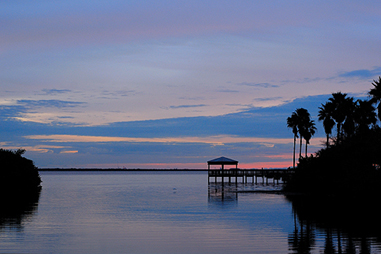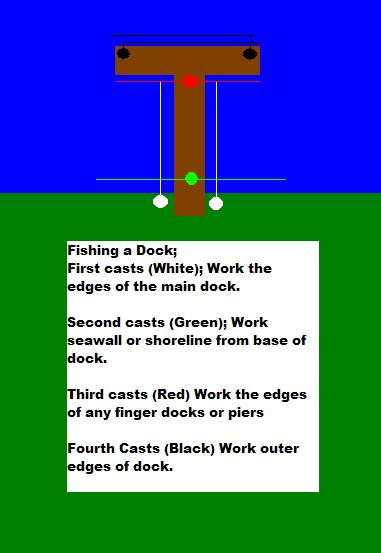|
 Between
the efforts of the Brevard County Parks
and Recreation Department, the various
efforts of individual cities and other
agencies there is an abundance of docks
overlooking the Indian River lagoon
system offering fishing opportunities
for the shore-bound angler. Most of the
time however the dock is seen merely as
a platform for fishing as far away from
the shoreline as possible and it is my
belief that far too many anglers will
simply walk past some of the best
opportunities of the day. Between
the efforts of the Brevard County Parks
and Recreation Department, the various
efforts of individual cities and other
agencies there is an abundance of docks
overlooking the Indian River lagoon
system offering fishing opportunities
for the shore-bound angler. Most of the
time however the dock is seen merely as
a platform for fishing as far away from
the shoreline as possible and it is my
belief that far too many anglers will
simply walk past some of the best
opportunities of the day.
In my mind there are a few simple facts
that no angler should ignore. Fish
require food, and they don't like to be
eaten themselves. In addition, any
structure in the lagoon, natural or
manmade will soon be colonized by
barnacles, oysters, algae, and other
attached life-forms which in turn
provide hiding places for many other
species of shrimps, crabs, small fish,
etc. Small schools of juvenile glass
minnows will also patrol these edges and
in turn, all this food will draw
gamefish.
On several occasions while walking out
towards the end of a dock or along a
seawall I have observed large trout,
snook, or redfish leaving the area,
spooked by my sudden appearance. I have
seen redfish patrolling along seawalls
within a foot of the wall looking for
food. I often see trout smashing into
schools of tiny baitfish along seawalls.
I have seen sheepshead foraging along
the seawalls and on the pilings of
docks. During the summer, large schools
of glass minnows will often gather along
docks, piers and bridges in deeper
waters and in turn attract school-sized
trout and other species such as ladyfish
and jack crevalle. These minnows will
often gather along deeper seawalls as
well. I have lain down on my belly on a
dock in order to wash my hands after
releasing a small seatrout. The water
was fairly clear that day and I could
see the bottom about 4 feet beneath the
dock and quickly realized I was seeing a
virtual aquarium of mangrove snapper and
other fish under the dock.
I have also noticed that many
professional guides who have access to
the entire body of water will often
position their guide boat so that their
clients can work baits and lures around
unoccupied docks. Trout will often seek
refuge from the mid-day sun in the heat
of the summer under deeper water docks.
The simple fact is that once a seawall,
bridge or dock has been built if becomes
a "mini ecosystem" that can and will
attract fish and should not be ignored.
 In
the diagram at left I outline a strategy
for fishing docks that has worked well
for me. This of course works best if you
are the first person at the dock before
cast-netters joggers and noisy fishermen
scare everything off. In
the diagram at left I outline a strategy
for fishing docks that has worked well
for me. This of course works best if you
are the first person at the dock before
cast-netters joggers and noisy fishermen
scare everything off.
I fish primarily with artificials and my
favorite lures for fishing along docks
are the Krocodile Spoon, 3/8 oz, chrome
finish, and the Rapala Original Floating
Minnow model F09, silver finish. If the
shoreline is not a seawall but natural
then usually the water is too shallow
for the Rapala, which dives when
retrieved. However, on occasion in these
extreme shallows you can encounter
snook, redfish or seatrout lying
motionless. For this I will use a
MirrOlure MirrOMullet. I fish these on
my standard 7' spinning outfit loaded
with 8 lb test line. I also use about
18-24 inches of 25 lb. monofilament
shock leader. When I approach a public
dock for fishing, I will stop at the
base of the dock and position myself
just to the side of the dock. My first
casts will be parallel to the dock as
close as possible on both sides. If the
sun is up give the shadier side a
greater priority. Then step onto the
dock just a few feet and do the same
along the seawall or shoreline. Next
work the finger docks the same way. And
finally work the outer edge. The most
important thing to remember is BE QUIET!
Fish have an organ called a lateral line
that runs the entire length of their
body. This thing is designed pick up
vibrations from a struggling minnow and
help them pick it off out of a school of
thousands so there is no doubt in my
find that it can pick up heavy footsteps
on a wooden dock. After working your way
out onto the end of the dock. Work the
open water around the dock but
occasionally make a cast back towards
shore along the edge of the dock. This
has worked for me on many occasions.
If you are fishing with live shrimp, try
free-lining a shrimp under the main body
of the dock from a finger dock or the
"T" of the diagram. If need be you can
use a small weight to get the bait
closer to the bottom. For sheepshead
concentrate on the dock pilings near the
bottom. For me this has always worked
better on docks that eventually extend
to a depth where the bottom is no longer
visible under normal conditions.
Good Luck!
Dean R. Pettit
|